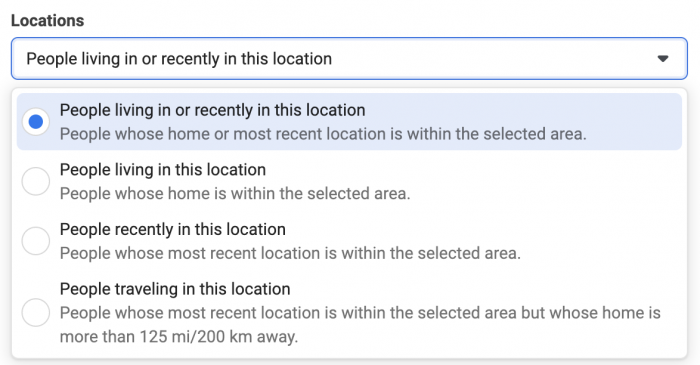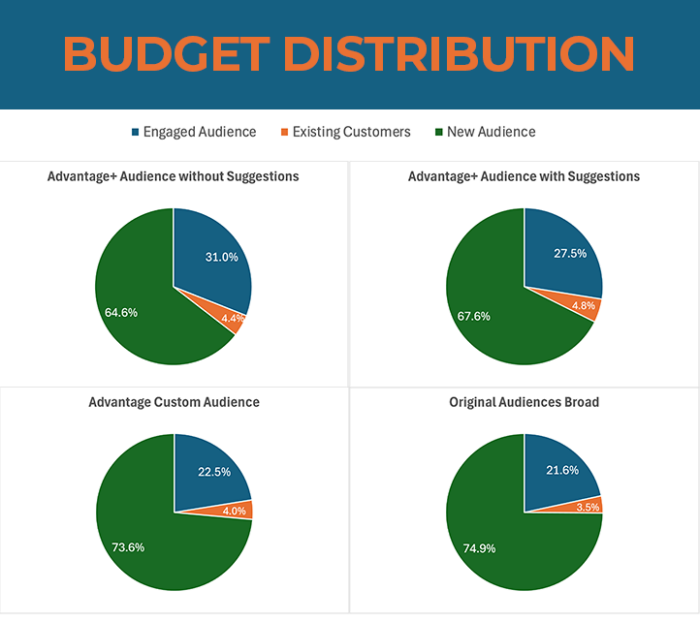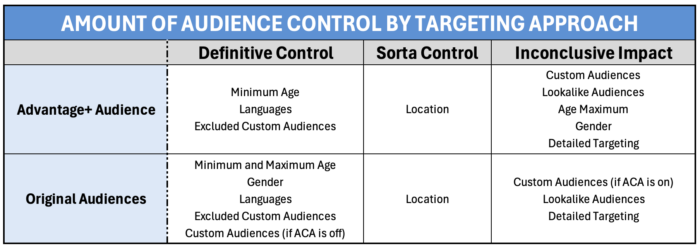There was a time when asking the question in today’s title would have been considered ridiculous. But, we can no longer ignore the trends. As much as we may want to fight it, targeting doesn’t matter nearly as much as it once did.
The way I phrased that was a soft landing. It left some wiggle room. Maybe it still matters, but not as much as before, right? But, let’s take it further.
It’s possible that targeting no longer matters at all.
Whoa, don’t come at me like that! I know. There are so many advertisers who still use the same strategy they’ve used for years. They insist it still works — and that it’s necessary. I know because I hear from them often.
I was one of those advertisers. If you were to go back far enough on this website, you’d begin to find quotes from me like this:
There are many factors that lead to success or failure of your Facebook ad campaign. But spoiler alert: Nothing is more important than targeting.
Or this:
Facebook ad targeting is one of the primary reasons why ads fail or succeed. You could have the perfectly crafted ad, but you shouldn’t expect it to work if it’s targeting the wrong people.
Things have changed. Our inputs mean less due to the move towards audience expansion and algorithmic targeting. In most cases, you can provide audience suggestions or inputs, but it’s questionable how much those inputs impact delivery.
And now that we have audience segments for sales campaigns, we can start to get more visibility into whether what we change matters at all.
Through my tests during the past month using four different ad strategies, it’s pretty clear: The strategy I chose did not seem to make any noticeable difference.
Allow me to explain…
Targeting Before
My quotes in the section above came from 2017, and I stand by them as being applicable at that point in time. Our targeting inputs absolutely did matter.
We defined the precise pool of people who should see our ads based on location, age, gender, custom audiences, lookalike audiences, and detailed targeting. Meta’s ad delivery optimization would then show ads to people within that pool who were most likely to convert.
If that initial targeting pool was flawed, we would not get results. Our inputs were important.
They were so important that Meta’s algorithm couldn’t fix broken targeting for us. It didn’t look at our inputs as suggestions. It didn’t prioritize our inputs initially before expanding to help us get better results.
We defined who could see our ads, and performance relied heavily on it.
Targeting Now
Of course, that’s no longer the case. The introduction of features like Advantage audience expansion and Advantage+ Audience means that we have various levels of control when it comes to who sees our ads:
- Things we definitively control
- Things we sorta control
- Things that have inconclusive impact and may not matter at all
The point of this article isn’t to say that today’s algorithmic targeting is better — or even that the control of the past was superior. Rather that it is what it is, and it’s possible that we’re paying far too much attention to factors we have little control over.
As we discuss control, I am going to focus only on cases when we’re optimizing for conversions. Otherwise, the factors that contribute to control will vary.
But, truthfully, if you’re able to optimize for conversions (and have conversion data available via the pixel or Conversions API), conversion optimization should be your priority. Top-of-funnel optimization is largely flawed, whether you control the audience or not.
What We Definitively Control
For each of these sections, we should differentiate between whether we’re using Advantage+ Audience or Original Audiences.
Advantage+ Audience: Factors We Control
- Minimum Age
- Languages
- Excluded Custom Audiences

These are within your Audience Controls. Meta will not serve ads to people under your set minimum age, within excluded custom audiences, or who don’t speak your selected language.
You may assume that location should fall here, too, but I omitted it intentionally. We’ll get to it.
Original Audiences: Factors We Control
- Minimum and Maximum Age
- Gender
- Languages
- Excluded Custom Audiences
- Custom Audiences (if Advantage Custom Audience is turned off)
There’s a bit more control here, but it’s minimal. When using Original Audiences, you can set a tight control on age range (both minimum and maximum) as well as gender. When using Advantage+ Audience, gender and custom audiences are suggestions (we’ll get to that). But when using Original Audiences, they are tight constraints.
What We Sorta Control
There’s one item that we omitted from above that we sorta control, and this applies to both Advantage+ Audience and Original Audiences: Location.

Way back in 2023, Meta changed our control over location targeting. Originally, we had four options:
- People living in or recently in a location
- People living in a location
- People recently in a location
- People traveling in a location

But, now it’s only “living in or recently in.” That means that you can’t isolate locals or travelers. This is why location is something we only sorta control.
No, Meta will not deliver your ads to people who don’t either live in or were recently in your selected location. You have control over that.
But, that doesn’t mean you have full control. If you want to only reach locals or travelers, you can’t. And that’s been a major frustration for advertisers.
What We Do That Has Inconclusive Impact
There’s a growing list of targeting inputs that we provide that may not matter at all. Or maybe they do. But, it’s not entirely clear whether they matter a lot, very little, or somewhere in between.
Advantage+ Audience: Inconclusive Impact
- Custom audiences
- Lookalike audiences
- Age maximum
- Gender
- Detailed targeting

All of these things are audience suggestions. It is entirely unclear whether they matter. Maybe they help give the algorithm initial direction. Maybe these suggestions are completely inconsequential.
Ultimately, your ads will be delivered to people who are likely to perform the action that you defined with your performance goal.
Original Audiences: Inconclusive Impact
- Custom audiences (if Advantage Custom Audience is turned on)
- Lookalike audiences
- Detailed targeting
When optimizing for conversions, Advantage Lookalike and Advantage Detailed Targeting are on by default and can’t be turned off. This means that your audience will be expanded and ads can be shown to people beyond those audiences.

In the case of custom audiences, you have the option of turning on Advantage Custom Audience.

Does that mean that if you get great results from your targeting inputs, expansion won’t happen? Does it mean that expansion always happens? Or does it mean that your inputs are no more than suggestions, like with Advantage+ Audience — this is simply a softer repackaging?
We don’t know. But, it’s entirely possible that inputs for audiences that can be expanded have minimal impact on delivery.
Here’s why I think that…
Look At This! (Targeting Test)

The image above is a summary of a test that I ran recently. It’s a sales campaign with four separate ad sets using a different targeting strategy:
- Advantage+ Audience without suggestions
- Advantage+ Audience with suggestions
- Original Audiences using custom audiences with Advantage Custom Audience turned on
- Original Audiences with no targeting inputs beyond country (going broad)
This test wasn’t about comparing performance (Cost Per Conversion) because too many factors impact that. But, if you’re curious, those results were almost exactly the same.
I was more concerned about whether my ads were delivered differently. I used audience segments to get an idea of how much of my budget was spent reaching my engaged audience and existing customers (in other words: Remarketing).
The difference was negligible and could be due to randomness, rather than the specific strategy.
Without getting too in the weeds of that test, my inputs or targeting strategy didn’t seem to have any impact on the distribution of my budget between remarketing and prospecting. At the very least, there’s strong evidence that at least 25% of my budget will go to remarketing, no matter what my approach.
The question we can’t answer is whether my strategy or targeting inputs impacted the prospecting audience. Since results are essentially the same, it would be logical to assume the difference is minimal. But, there’s no way to say for sure.
Does Remarketing Matter?
There was a time when remarketing made up a very large percentage of my advertising efforts. But, that’s no longer the case. More accurately, I no longer create ad sets that isolate custom audiences.
In the section about targeting we definitively control, custom audiences is listed under Original Audiences (assuming you turned Advantage Custom Audience off). You can still run remarketing campaigns. But, the question is whether you should.
As you can see in my pie charts above, between 25 and 35% of my budget was spent on remarketing using all four strategies. This includes using Advantage+ Audience without suggestions and Original Audiences while going broad.
I should also mention that it’s possible, if not extremely likely, that even more than that is spent on remarketing. Audience segments for engaged audience and existing customers do not include engagement custom audiences. So, we don’t know how much of my budget is spent on people who engaged with my ads, but didn’t click to my website, make a purchase, or join my email list.
While I don’t explicitly run remarketing campaigns, I’m still remarketing. And that’s kind of the beauty of how Meta is distributing my budget. Prospecting and remarketing happens all within a single ad set.
What This Could Mean
If what I’ve found in this limited test scales and isn’t a random blip, it should make you think about how you run ads.
It may not matter whether you use suggestions with Advantage+ Audience.
It may not matter whether you use Advantage+ Audience or Original Audiences and go broad.
It may not matter if you use Original Audiences with one of the targeting options that expands your inputs.
It’s quite possible that in all cases, Meta’s ad delivery algorithm will dedicate a similar percentage of your budget to remarketing and the rest to prospecting.
When I discovered this possibility, it was freeing. When you realize that none of your inputs make that much of a difference, you stop obsessing over how you do it. It allows you to focus more of your time on ad copy and creative.
But, just as importantly, you realize that all of those separate ad sets to segment your targeting were probably completely unnecessary. Because each ad set, assuming the audience was impacted by expansion, likely reached a very similar group of people. You’re better off consolidating your budget.
My takeaway is that Advantage+ Audience without suggestions is likely sufficient for me. And there’s no reason to run multiple ad sets in one campaign at the same time for the purpose of segmenting targeting groups.
The main exception to this could be if you need to tightly control the ads that are shown to individual audience segments, but that should not be the norm for most advertisers. And ultimately, you could hurt your performance by forcing such control.
So… Does Targeting Still Matter?
I don’t have a definitive answer for you. There’s still too much we do not know about the impact of our inputs and how our ads are delivered.
At the very least, our targeting inputs certainly mean far less than they did before. Remarketing isn’t necessary, in many cases. It’s possible that you only need to use Advantage+ Audience without suggestions now, assuming you’re optimizing for conversions.
I’ve seen enough to decide that these inputs are no longer impactful enough (if at all) to be all that concerned about them. Because it seems that no matter what approach I take, my ads get delivered in a similar manner.
Summary Grid
I put together a grid to summarize the level of audience control advertisers have over targeting, broken down by approach. I’ve been told that people like summary grids. So, here you go…

Your Turn
What’s your feeling about targeting these days? Does it still matter?
Let me know in the comments below!







